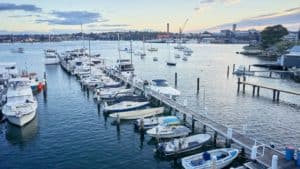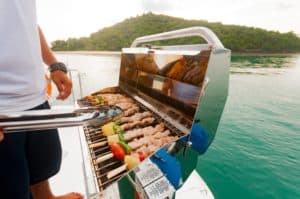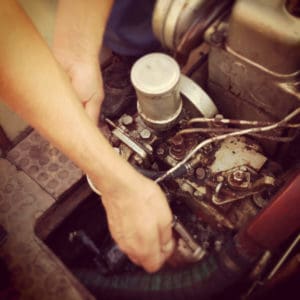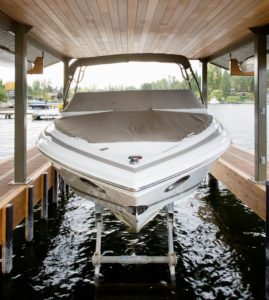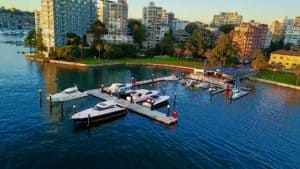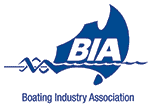Berthing at the marina can be a challenging experience even for those experienced in boating. To help you master berthing your vessel, we have put together a quick guide providing steps for a proper berth. We have also added some useful tips to help you berth in any condition you may find.
Steps For Berthing
Here is a simple 8 step process for berthing successfully.
- Determine the type of wharf for your berth; pontoon or fixed.
- Find the easiest side of the pontoon or wharf to berth on and determine your best approach angle.
- Prepare the fenders at a height and position on the vessel appropriate to the wharf or pontoon you are approaching.
- Prepare any ropes needed to secure the vessel after it’s berthed. You’ll need a stern line and a bow line to secure the boat to the wharf. You’ll also need at least one springer line to prevent fore and aft movement.
- Slowly approach the wharf in a straight line on your ideal angle.
- Rotate the vessel at the proper moment to have it moving slowly in parallel with the wharf.
- Slow the vessel and bring it to a stop alongside the wharf or pontoon.
- Using the stern line, secure your vessel to the wharf.
There are some important points to remember when berthing:
- Berthing your vessel is best done at idle revs.
- Berthing is easier if the wind is blowing you towards the wharf or pontoon; ideally, wind at your stern.
Professional Berthing Tips
Berthing your boat is simple in theory but much more difficult in practice. You could be an excellent sailor and still struggle with marina berthing.
Here are our best tips to help you master your berthing.
1. Know Where You’re Going
When you visit a marina for the first time, the arrangement of the pontoons and the berth numbering system are often not clear. It’s helpful to look in advance to see if this information is available in charts of the area or in a pilot book. With this information, you’ll know exactly where you’re going and are less likely to face a challenging situation.
2. Determine What The Wind Is Doing
Apart from the tide, the wind is the most important factor influencing boat handling. It is the biggest factor in marinas in non-tidal areas, locked basins, and some dock basins. It’s important to remember that wind gusts have a larger effect when moving at slow speeds or maneuvering in a confined space.
3. Mind The Tide
In a marina in a river or estuary, the tidal stream will likely be the biggest influencer of boat handling. It’s important to know the direction the tide is flowing before entering a confined space. Be aware of its strength, both in the outer part of the marina near the faster streams and the inner pontoons where the streams are weaker.
If you need to turn around in this kind of marina, turn in the direction that will keep the bow pointing into the stream. This allows you to stem the tide mid-turn, effectively increasing the room you have available. In contrast, if you attempt to turn the bow downstream you’ll likely run out of space quickly.
4. Be Extra Careful Of Cross Tides
Most marinas are designed so tidal streams are parallel to the pontoons you moor alongside. However, sometimes this is not the case when a marina is located near the bend of a river. In this situation, the stream can create a considerable angle to the berths. Furthermore, the angles of cross tides can vary during different stages of the tidal cycle.
5. Use Mid-Ships Spring
This likely won’t be necessary if you have a large crew full of people who are experienced and know exactly what they’re doing. But, if you’re sailing short-handed, using a midships spring is a useful tool.
A short spring led from a midships cleat will help secure your boat in its berth. Additionally, when leaving a berth, this spring enables you to cast off all other lines first. This leaves just the spring which can be easily slipped if necessary.
6. Use Fenders If You Need To
When berthing errors do arise, fenders provide a necessary shield between your boat, the dock, and other vessels. Fenders won’t improve the handling of your boat but can help alleviate some of the concerns stemming from an accident. This will help you focus more on maneuvering and lead to more successful berths.
7. Identify A Bail-Out Point
It’s helpful to identify in advance the point where you must fully commit to a maneuver. Doing so lets you know the last point that you can bail out if things aren’t going to plan. This will allow you to look at a potentially difficult berth while keeping a safe exit option open.
Berthing In Windy Conditions
Windy conditions have a considerable impact on the handling of your boat.
Berthing with the wind can be easier. You can slow your approach to the berth by reversing your engine’s power, head bow in, tie off and use that line to pivot in.
Berthing when the wind is blowing away from the wharf is much more difficult. To start, you’ll want to be 90 degrees to the wharf on your initial approach. Doing so will minimize the turning effects of the wind.
The maneuver requires you to use quick and aggressive use of steering and throttle. You want to use the momentum of the boat to your advantage. Run your boat towards the wharf and give the throttle a firm but controlled surge of power as you make the final turn.
When performed correctly, the boat will slide into its berth using this rotary motion, coming to a stop at the perfect spot.
Premium Harbor Locations
Let’s get you on the water in Sydney. Corleone Marinas has four beautiful marina locations across Sydney including Balmain, Drummoyne, Elizabeth Bay, and Long Island. We offer a full range of marina services including wet berths, moorings, and slipways for boats up to 60 feet.
All berths include power and water and our friendly dockmasters are on hand to assist with arrival and departures seven days a week.
Contact us today to learn more about all we have to offer.


